MSI’s ECO Range of Motherboards Announced
by Ian Cutress on July 10, 2014 6:45 AM EST- Posted in
- Motherboards
- MSI
- Haswell
- ECO
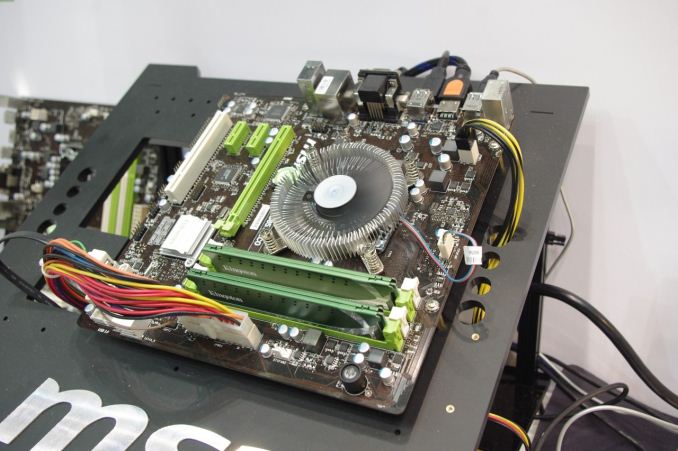
At Computex this year, the MSI booth featured a range of new motherboards branded ‘ECO’, with the emphasis on minimizing power output while still retaining a level of functionality. Today we received the official announcement for the range, which will initially encompass three models: the H97M ECO, the B85M ECO and the H81M ECO. Each of these models will be in the micro-ATX form factor, offering one PCIe 3.0 x16, two PCIe 2.0 x1 and one PCI slot. At this point in time all the PCBs are in black, rather than the white edition we saw at Computex which might come at a later date.
All three models use a simple power phase design without the need for a heatsink. As none of these chipsets support CPU overclocking, MSI only has to deal with TDP allowances. In our initial Computex coverage, reader TiGr1982 commented that these motherboards should throw up an image at boot if an S or T low power processor was not detected – it would be interesting to see if MSI would implement such a feature.
Each motherboard uses Intel NICs, USB 3.0 and six SATA 6 Gbps, except the H81 which uses two SATA 6 Gbps plus two more SATA 3 Gbps ports due to chipset limitations. The H81M ECO also uses only two DRAM slots, whereas the others have four. MSI is branding its ECO range as a 40% power saving, while retaining 100% performance and stability. The main feature to help this is their ECO Center Pro software, which allows users to switch off ports and slots not being used. For example, PCIe slots with no cards, or disabling USB ports/NICs/fan headers as required thus saving extra milliwatts.
MSI’s overclocking motherboards over recent generations have included an OC Genie button on board, and for the ECO range this turns into the ECO Button which helps reduce power usage. The button is also toggled in the BIOS, and MSI retains its Military Class rating for these new products.
The ultimate ECO board might be a severely stripped down mini-ITX motherboard with the bare essentials, with an integrated processor and DDR3L, however for custom build PCs there has to be that balance of configurability and power saving. MSI is focused on small business, data center and system integrators for its range.
I am currently awaiting release dates and pricing for these new models. Product pages are not available online yet, but I will update this post when I have links and information.
Addition:
Just got word of MSRPs for North America. The H97M ECO will be $90, and the B85M ECO will be $75. It looks like the H81M ECO will be for SIs only or for other markets.


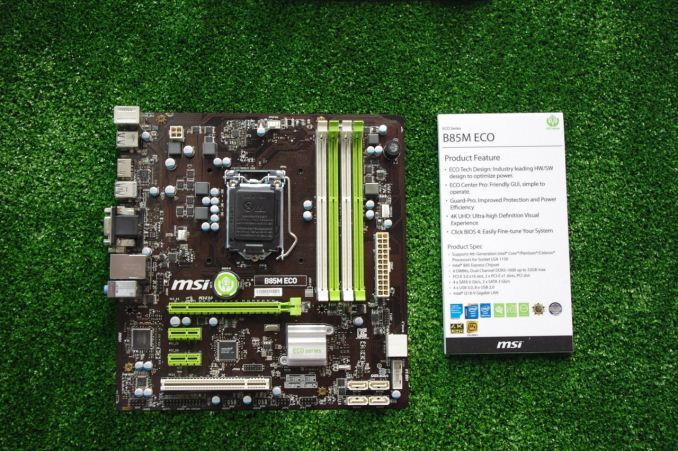

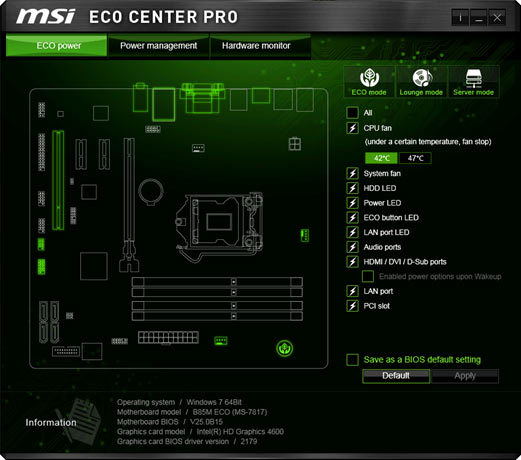
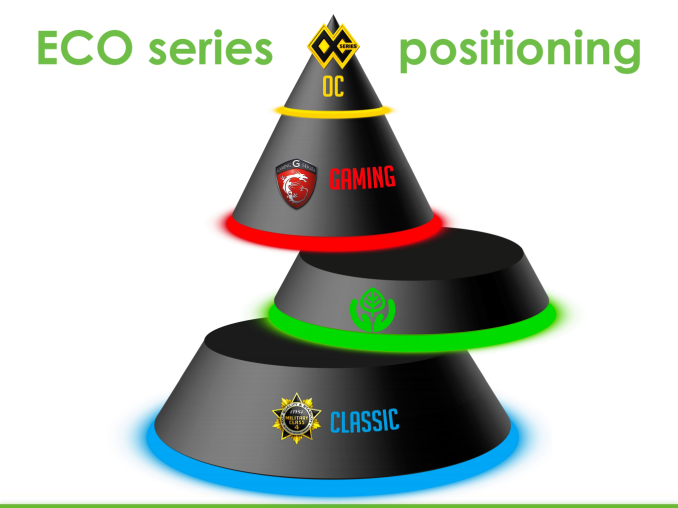
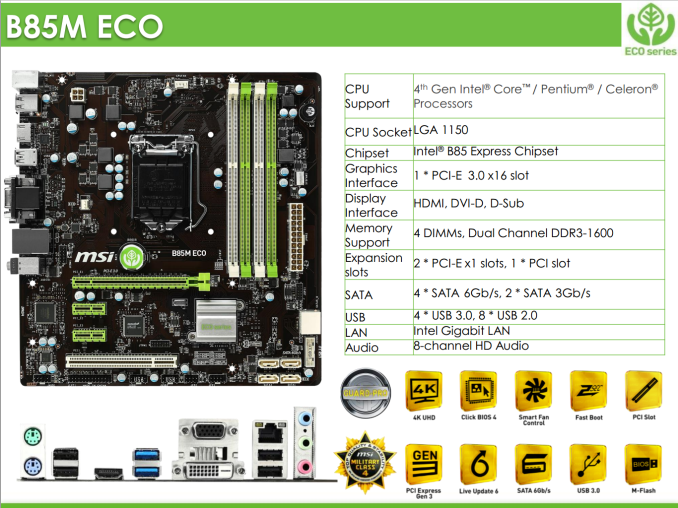








28 Comments
View All Comments
purplestater - Friday, July 11, 2014 - link
MSI has been my board of choice for well over ten years. I tend to look at BioStar next, but I don't build power-gamer PCs. As it is MSI and BioStar are simply dependable. While I've never had any real operational problems with ASUS boards, they've always caused me the most general annoyances. After buying three different models that would not boot if the integrated NIC was enabled without a cable being inserted, I'd had my fill.Flunk - Thursday, July 10, 2014 - link
After the title I was assuming this would be about a line of Baytrail using < 15W for the entire board and CPU. Calling boards for high-end Haswell processors is rather disingenuous because the vast majority of the power usage is the CPU, the board really doesn't use hardly anything.This is just a pointless marketing exercise. They've just slapped the "ECO" name on a couple of low to mid tier boards and pushed them out the door.
madmilk - Thursday, July 10, 2014 - link
The motherboard is responsible for most of the idle power consumption on modern desktops. Quad-core Haswell laptops with discrete graphics idle at around 15 watts at the wall, including the display. Most desktops have trouble making it below 30 watts, not including the display.DanNeely - Friday, July 11, 2014 - link
Your accusation is something that I hope will be looked at closely when these are reviewed. What I'm hoping MSI did is to use more power efficient components on these boards than on typical budget boards to get significantly idle power reductions.lever_age - Thursday, July 10, 2014 - link
"reader TiGr1982 commented that these motherboards should throw up an image at boot if an S or T low power processor was not detected"Actually, if you're doing X amount of work in Y amount of time, often the standard-voltage processors out of box consumer less energy doing so because they can complete the task faster and go back to a lower power state for longer. The S and T processors are more for thermally or power constrained applications, not for saving energy.
If these boards are more serious about being ECO, I wonder if they support underclocking and undervolting.
lever_age - Thursday, July 10, 2014 - link
uh, consumer --> consume.extide - Thursday, July 10, 2014 - link
Yeah, that is very true, but also people for some reason thing S and T series CPU's magically use less power and get the same performance. They don't. ALSO, regular TDP chips will still idle down just as low as a S or T series one! The low-tdp chips only make a difference if the box is pegged all the time, really!PEJUman - Thursday, July 10, 2014 - link
I maybe wrong with this, but I am under the impression that the T and S moniker are meant for binned processor with better perf/watt slope. for example: K series 100 'units' of compute @ 88W = 1.1 perf/watt. where the T/S series would do 80 'units' of compute @ 40W = 2 perf/watt.assuming both would idle the same way, the T/S actually saves power.
Note: I pulled these numbers out of my 4$$, just to illustrate the thought process.
Zap - Friday, July 11, 2014 - link
I don't know exactly what Intel does for the various T, S and K chips. For all we know, they could all be exactly the same, and just "set" at the end of manufacturing for their roles.I do know that in practice there are some differences, but it may not be enough to make a huge overall difference in power draw. What it does do is to hard cap power draw (and resultant heat output).
SPCR did an article regarding this: http://www.silentpcreview.com/intel-2100t-2400s
Qwertilot - Friday, July 11, 2014 - link
Doesn't seem to be tested often :) Only thing with that silent pc article is that its sandy and Haswell maybe a bit different. With them seemingly focusing the design on notebooks, I guess you'd maybe expect the performance around 35/45W to benefit somewhat.There's a decent test of here of one of the 35w Haswell i7's here: http://www.anandtech.com/show/7604/asrock-m8